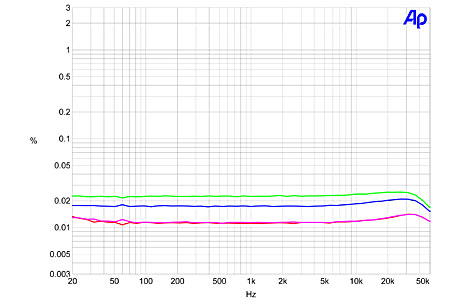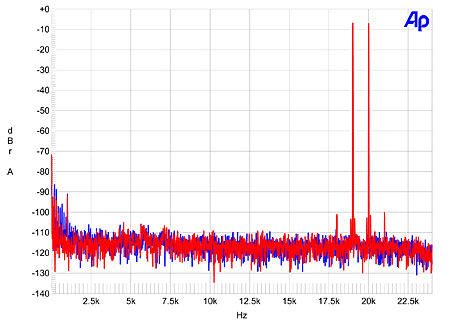| Columns Retired Columns & Blogs |
Vincent Audio KHV-1pre headphone amplifier/preamplifier Measurements
Sidebar 3: Measurements
I measured the Vincent Audio KHV-1pre using Audio Precision's top-model SYS2722 system (see www.ap.com) for most of the tests, with some use made of the magazine's original AP System One. Both the preamplifier and the headphone outputs preserved absolute polarity; ie, were non-inverting. The maximum gain assessed at the preamp output jacks was 17.1dB; this increased to 25.8dB at the headphone jacks. Both figures are higher than required for real-world listening, meaning that the volume control will be used mainly at the lower end of its range, as WP found. Fortunately, the control's channel balance was fairly good, the maximum error being 0.68dB in favor of the left channel at the 9 o'clock setting. The best balance was with the volume control set to its maximum, when the right channel was just 0.09dB higher in level.
The KHV-1pre's input impedance was usefully high, at 38k ohms across the audioband. The output impedance from the headphone jacks was 16 ohms at all frequencies, which is slightly higher than optimal (see Keith Howard's article on headphone performance in the August 2008 issue). Measured at the preamplifier output jacks, the source impedance was a moderately low 680 ohms at high and middle frequencies, but rose to 6.2k ohms at 20Hz, which will lean out the low frequencies if the KHV-1pre is used with a power amplifier having an input impedance of less than 20k ohms or so. WP used the Vincent as a preamplifier with a NuVista 300 power amplifier, which has an input impedance of 64k ohms, so there weren't any matching problems there.
Measured at the headphone output, the Vincent's frequency response was basically flat, with a slight, 0.25dB rolloff at 20kHz and a –3dB point of 120kHz (fig.1). The low end was flat, even into 600 ohms (green and magenta traces). The top-octave rolloff was slightly greater from the preamplifier output (fig.2), but the main point to note in this graph is the premature rolloff at low frequencies into the 600 ohm load (green and magenta) compared with the response into 100k ohms (blue and red). This is due to the Ohm's Law interaction between the rising source impedance at low frequencies and the load impedance. In practice, of course, the Vincent preamplifier outputs will never see a load as low as 600 ohms. Channel separation (not shown) was better than 65dB across most of the audioband, decreasing slightly above 10kHz.

Fig.1 Vincent KHV-1pre, headphone output, frequency response at 1V into: 100k ohms (left channel blue, right red), 600 ohms (left channel green, right magenta). (0.25dB/vertical div.)

Fig.2 Vincent KHV-1pre, preamplifier output, frequency response at 500mV into: 100k ohms (left channel blue, right red), 600 ohms (left channel green, right magenta). (0.25dB/vertical div.)
The signal/noise ratio, assessed with the input shorted but the volume control set to its maximum, was respectable at 76.3dB ref. 1V output with an unweighted, wideband measurement. A-weighting increased this to 86.5dB. The plot of the headphone output's THD+noise percentage against voltage into impedances ranging from 60 ohms (the impedance of the AKG K701 headphones used by WP in his auditioning) to 100k ohms (fig.3) is actually dominated by the noise below 1V, any distortion components being buried under the noise floor. True distortion makes its presence known as the rising trend in the traces above 1V, but even into 60 ohms, the Vincent's headphone output can deliver 3V before the THD crosses the 0.1% threshold and 8V is available at the usual definition of clipping (1% THD). The plot of THD+N from the preamplifier output into 100k ohms (fig.4) reveals that the right channel was more linear than the left, but the overall shape of the traces is the same as in fig.3, suggesting that it is overloading of the tube stage that limits the KHV-1pre's headphone output. (The waveform clips asymmetrically as the output level rises above 2V.)

Fig.3 Vincent KHV-1pre, headphone output, distortion (%) vs 1kHz output voltage into (from bottom to top at 1V): 100k, 600, 60 ohms.
Because it appears to be taken directly from the tube circuit, the preamplifier output will not drive low impedances without adding distortion. Fig.4 indicates that at a 1V level into a high 100k ohm load, the KHV-1pre's left channel still offers respectably low distortion, at 0.066%. When then load was reduced to 10k ohms, a typical figure for many solid-state power amplifiers, the THD rose to 0.24%, which may start to be audible. With 3k ohms, the KHV-1pre suffered from 1% THD at 1V, which was well into clipping. So even if the low-frequency rolloff with low impedances will not be an issue, the Vincent's preamplifier output is best used with a power amplifier having an input impedance greater than 30k ohms.

Fig.4 Vincent KHV-1pre, preamplifier output, distortion (%) vs 1kHz output voltage into 100k ohms, right channel bottom at 1V, left channel top at 1V.
Measured at the headphone output, the THD+N percentage remains both low and constant with frequency (fig.5), but with the right channel again more linear than the left. Fig.6, taken into 100k ohms, reveals that this is because the left channel has a bit more of the subjectively innocuous second harmonic than the right. Though both channels have almost as much third harmonic as second, these harmonics are low in absolute terms, and there are no higher-order harmonics visible above the noise floor—always an indicator of good sound quality. Dropping the load to 60 ohms made very little change in the picture (fig.7) other than slightly increasing the level of the third harmonic and the fourth harmonic making an appearance, although at –104dB (0.0006%), the latter will not upset anyone.

Fig.5 Vincent KHV-1pre, headphone output, THD+N (%) vs frequency at 1V into 100k ohms (left channel blue, right red), 300 ohms (left channel green, right magenta).

Fig.6 Vincent KHV-1pre, headphone output, spectrum of 1kHz sinewave, DC–10kHz, at 1V into 100k ohms (linear frequency scale; left channel blue, right red).

Fig.7 Vincent KHV-1pre, headphone output, spectrum of 1kHz sinewave, DC–10kHz, at 1V into 60 ohms (linear frequency scale; left channel blue).
The intermodulation distortion of the Vincent's headphone output was very low into 100k ohms (fig.8); though the 60 ohm loading brings up the levels of the intermodulation components (fig.9), they remain low in absolute terms. As WP found, the KHV-1pre has no difficulty driving even low-impedance 'phones like the AKG K701.

Fig.8 Vincent KHV-1pre, HF intermodulation spectrum, DC–24kHz, 19+20kHz at 1V peak into 100k ohms (linear frequency scale; left channel red, right blue).

Fig.9 Vincent KHV-1pre, HF intermodulation spectrum, DC–24kHz, 19+20kHz at 1V peak into 60 ohms (linear frequency scale; left channel blue).
The Vincent Audio KHV-1pre offers excellent measured performance. The only compromise resulting from using a tubed gain stage is that the preamplifier's output is limited in its ability to drive impedances much below 30k ohms. But in its prime role as a headphone amplifier, it will be bombproof. Yes, I would like to have seen a lower output impedance, but with higher-impedance headphones such as the various Sennheiser HD models, the Vincent will perform impeccably. Because the AKG K701's impedance remains relatively constant with frequency, there will be little modification of the 'phones' frequency response by the Vincent. Only with the low-impedance Grados might the 'phones' low frequencies get a little bit of a boost from the usual Ohm's Law interaction.
Addendum, Sample 2: The second sample of the KHV-1pre measured identically to the first in most respects: maximum gain from headphone and RCA jacks, maximum output levels, frequency response, and distortion spectra. Though the input impedance was a little bit higher, at 45k ohms across most of the audioband, this is inconsequential. While the output impedance measured at the sole headphone jack was the same as the first sample, the preamplifier output impedance from the RCA jacks was a little higher at high and middle frequencies, at 1100 ohms. Most importantly, this was now maintained down to 20Hz instead of rising to >6k ohms, as it had with the first sample. Current production of the KHV-1pre will therefore be better matched to typical power amplifier input impedances, and will not suffer from prematurely rolled-off lows.—John Atkinson
- Log in or register to post comments




































